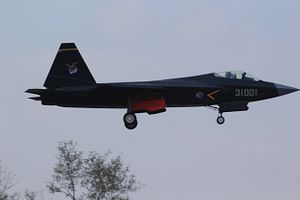According to a new report from Bradley Perret and Stephen Trimble, the Shenyang J-31 stealth fighter is once again on the menu for the Chinese military. The J-31 is the second stealth aircraft developed by Chinese industry, after the Chengdu J-20. This news is mildly surprising, as for the past few years the Chinese military has been lukewarm about the J-31, concerned that its performance did not merit domestic acquisition.
Apparently, the PLAN is unsatisfied with the performance and growth potential of the J-15 as a carrier-based fighter. In itself, this should not be surprising; the J-15 is a copy of the Russian Su-33, itself developed from a land-based fighter originally introduced in the mid-1980s. China is building a fleet of new carriers, and it seems that the PLAN is interested in something newer than an adapted 35-year-old platform. In any case, China appears to have specific concerns about the stability of the J-15 in landings, a major problem for a carrier aircraft.
For a while, it appeared that China would attempt to export the J-31 in an effort to crack into the extremely limited export market for 5th generation fighters. At the moment, that market is entirely occupied by the Lockheed-Martin F-35, which runs afoul of defense budgets and export controls. But China doesn’t have a great track record exporting high-end fighter aircraft (it’s been better with mid-range aircraft) making the J-31 a substantial risk for customers.
Moreover, the United States has repeatedly suggested that the J-31 depends on several technologies stolen from the F-35, which might also create concerns for fighter customers sensitive to U.S. intellectual property law. The ability of the United States to interfere with arms transactions between China and Russia portends ill for states that try to purchase technologies that the U.S. regards as stolen.
Unlike the F-35, the J-31 has two engines, making it more palatable to the naval aviation community. These engines will reportedly be a upgrade of the WS-13 engine currently used by the JF-17. Given that China continues to struggle with the larger, more complex engines on the J-20, this success may serve to make the J-31 an even more attractive option. Indeed, Perret and Trimble also report that the PLAAF will acquire some number of J-31s, given that the navy will be paying the bulk of development and testing costs in any case.
Problems remain with the J-31. While the airframe seems to strongly resemble the F-35, there is little reason to believe that it integrates the kind of technology suite that makes the F-35 uniquely lethal. Moreover, the J-31 still requires years of development. But at this point, it looks like the PLAN may have a plan for its first real generation of carrier aircraft.
The views expressed here are his personal views and do not necessarily reflect those of the Department of Defense, the U.S. Army, the Army War College, or any other department or agency of the U.S. government.
































